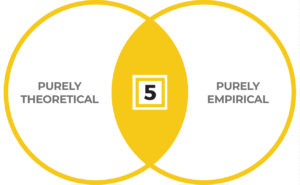Despite the field of positive psychology being relatively young the quest to understand the factors that drive human behavior, decisions, and feelings is eternal. Conceptually, there are two major research approaches that one can take to develop a model to develop the latter.
 First – the fundamental or “theoretical” approach. The main focus of a theoretical approach, serving as a base for assessments such as the “VIA Survey” by Martin Seligman, is to advance our scientific knowledge for a more thorough understanding of a topic or certain phenomenon. It deals with the formulation of a theory about human behavior, which can then be generalized across populations. This also constitutes the main advantage of this approach: once a theory is developed, it is universally applicable.
Second – the applied approach. The main focus of such an approach, underlying such assessments as the “Strengths Finder” by Don Clifton, is to understand and solve a specific real-life, empirical problem. Unlike the theoretical one, the applied approach starts with collecting as much real-life data as possible and then trying to structure it into a framework to achieve a specific objective. The main advantage of this approach lies in the practical applicability of its results.
Simplifying the discussion, the main difference between applied and fundamental research is that findings of applied research can be applied to resolve specific issues, whereas fundamental studies are used to explore overarching principles. While both have their own advantages, both have their cons. Purely theoretical models lack concrete applicability of their results, while purely empirical models lack applicability across populations.
Conscious of this, our HIGH5 approach & methodology aimed to combine the best of these two perspectives. You can find it outlined in the next section.
First – the fundamental or “theoretical” approach. The main focus of a theoretical approach, serving as a base for assessments such as the “VIA Survey” by Martin Seligman, is to advance our scientific knowledge for a more thorough understanding of a topic or certain phenomenon. It deals with the formulation of a theory about human behavior, which can then be generalized across populations. This also constitutes the main advantage of this approach: once a theory is developed, it is universally applicable.
Second – the applied approach. The main focus of such an approach, underlying such assessments as the “Strengths Finder” by Don Clifton, is to understand and solve a specific real-life, empirical problem. Unlike the theoretical one, the applied approach starts with collecting as much real-life data as possible and then trying to structure it into a framework to achieve a specific objective. The main advantage of this approach lies in the practical applicability of its results.
Simplifying the discussion, the main difference between applied and fundamental research is that findings of applied research can be applied to resolve specific issues, whereas fundamental studies are used to explore overarching principles. While both have their own advantages, both have their cons. Purely theoretical models lack concrete applicability of their results, while purely empirical models lack applicability across populations.
Conscious of this, our HIGH5 approach & methodology aimed to combine the best of these two perspectives. You can find it outlined in the next section.
 First – the fundamental or “theoretical” approach. The main focus of a theoretical approach, serving as a base for assessments such as the “VIA Survey” by Martin Seligman, is to advance our scientific knowledge for a more thorough understanding of a topic or certain phenomenon. It deals with the formulation of a theory about human behavior, which can then be generalized across populations. This also constitutes the main advantage of this approach: once a theory is developed, it is universally applicable.
Second – the applied approach. The main focus of such an approach, underlying such assessments as the “Strengths Finder” by Don Clifton, is to understand and solve a specific real-life, empirical problem. Unlike the theoretical one, the applied approach starts with collecting as much real-life data as possible and then trying to structure it into a framework to achieve a specific objective. The main advantage of this approach lies in the practical applicability of its results.
Simplifying the discussion, the main difference between applied and fundamental research is that findings of applied research can be applied to resolve specific issues, whereas fundamental studies are used to explore overarching principles. While both have their own advantages, both have their cons. Purely theoretical models lack concrete applicability of their results, while purely empirical models lack applicability across populations.
Conscious of this, our HIGH5 approach & methodology aimed to combine the best of these two perspectives. You can find it outlined in the next section.
First – the fundamental or “theoretical” approach. The main focus of a theoretical approach, serving as a base for assessments such as the “VIA Survey” by Martin Seligman, is to advance our scientific knowledge for a more thorough understanding of a topic or certain phenomenon. It deals with the formulation of a theory about human behavior, which can then be generalized across populations. This also constitutes the main advantage of this approach: once a theory is developed, it is universally applicable.
Second – the applied approach. The main focus of such an approach, underlying such assessments as the “Strengths Finder” by Don Clifton, is to understand and solve a specific real-life, empirical problem. Unlike the theoretical one, the applied approach starts with collecting as much real-life data as possible and then trying to structure it into a framework to achieve a specific objective. The main advantage of this approach lies in the practical applicability of its results.
Simplifying the discussion, the main difference between applied and fundamental research is that findings of applied research can be applied to resolve specific issues, whereas fundamental studies are used to explore overarching principles. While both have their own advantages, both have their cons. Purely theoretical models lack concrete applicability of their results, while purely empirical models lack applicability across populations.
Conscious of this, our HIGH5 approach & methodology aimed to combine the best of these two perspectives. You can find it outlined in the next section.
